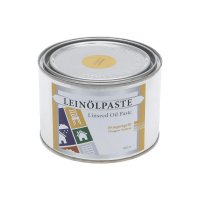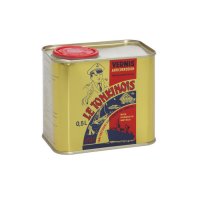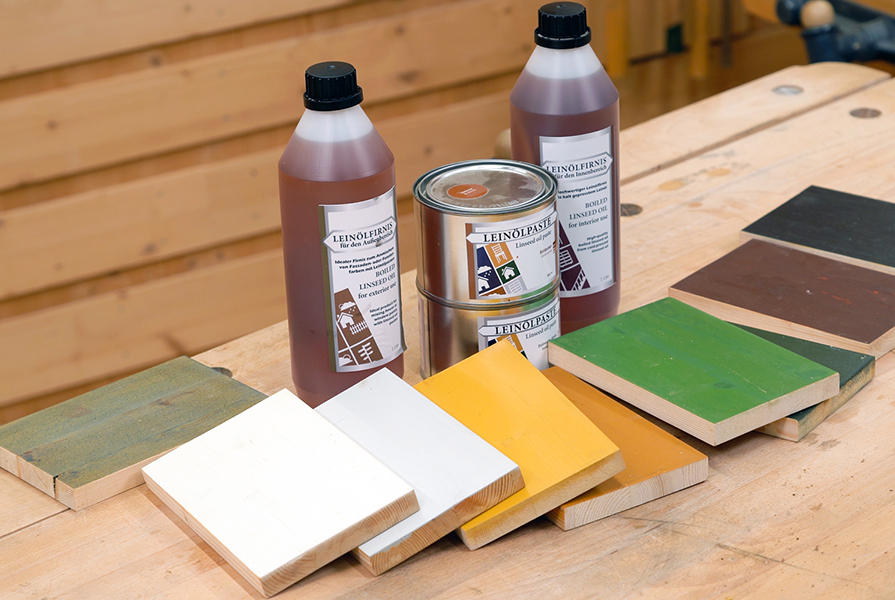
- What threats is wood exposed to outdoors?
- Boiled linseed oil
- What is the difference between interior and exterior varnishes?
- Which linseed oil paints are recommended for outdoor use?
- What are the alternatives to boiled linseed oil?
- How do I apply linseed oil paints?
- Step-by-step guide to preserving wood for outdoor use
- Can I renovate old coats with linseed oil paints?
Wood is exposed to numerous threats, especially outdoors. It is a natural process that dead wood, which is no longer nourished by the tree's roots, decomposes through the influence of microorganisms and the UV rays of sunlight. In the case of processed wooden components, it is important to counteract these environmental influences.
What threats is wood exposed to outdoors?
UV-light degrades some components of the wood, especially the lignin. If the wood surface is exposed to weather, the water-soluble degradation products of the lignin are washed out, leaving behind the photochemically stable, silvery-white cellulose. In addition to purely visible changes in the colour of the wood, it is subjected to greying. Dew and rain dampen the wood, which leads to a colonisation of dark-coloured moulds and to the penetration of dust particles, so that the surface turns grey to black over time.
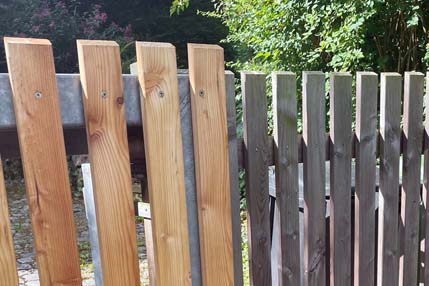
Garden gate and fence made of larch wood. The older fence has already visibly greyed.
Wood pests also contribute to the degradation process of wood. The risk of timbers being attacked by insects or fungi depends on the moisture content of the wood. By applying constructive measures, the risk of fungal infestation can be reduced. Fungi need a wood moisture level of at least 20 % to be able to infest the wood. Assuming a functioning constructive wood protection, the wood moisture level of 15 to 18 % outdoors is therefore too low for fungi. If constructive wood protection is not permanently guaranteed, timber must be protected against fungal attack by impregnation or a protective coat.
Animal wood pests are usually the larvae and not the adult beetles. Depending on the living conditions and larval species, these live between one and ten years in the wood before they pupate and then hatch as beetles. Beetles only has a life expectancy of three to five weeks and do not eat during this time. Most insect pests are green wood insects, which lay their eggs only in fresh wood. In Germany, there are only three domestic wood pests that attack timber that has already been installed. The drywood insects include the small woodworm or the death-watch beetle, the house longhorn beetle (large woodworm) and the brown powder-post beetle. Cracks which form in the wood due to inadequate wood protection, are gateways for wood pests.
Boiled linseed oil
Boiling linseed oil initiates a polymerisation process in which the oil thickens slightly. This process is halted when the oil cools down and is stored in an airtight container (airtight atmosphere). Siccatives (drying agents) are mixed with the oil in the boiling process. The amount and type of drying agent determines the drying time, but also the environmental impact of the varnish.
For linseed oil varnishes, DICTUM only uses seasoned and degummed, cold-pressed linseed oil that was gently boiled to remain runny and thus deeply penetrate and quickly dry. The manganese siccatives used for the boiled linseed oil are among the most environmentally compatible drying agents and their addition is strictly controlled. This significantly reduces the drying time and thus ensures a stain-free coat even in unsettled weather.
What is the difference between interior and exterior varnishes?
First off: Linseed oil varnish has no UV protection due to its clear colour and should therefore only be used in combination with linseed oil pastes for exterior use.
Boiled Linseed Oil for Exterior Use is made of high-quality cold-pressed linseed oil to which a small amount of manganese siccative is added during the boiling process. To ensure long-term protection against fungal attack, we add a small amount of IPBC fungicide.
Boiled Linseed Oil for Interior Use is also made of cold-pressed linseed oil to which a small amount of manganese siccative is added. However, it does not contain fungicide. When mixed with pigment pastes that have a high zinc content and thus have their own fungal protection, this varnish can also be used for exterior paints without fungicides. Zinc provides longer-lasting fungal protection.
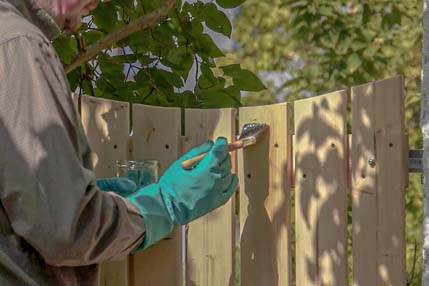
The wooden gate is primed with boiled linseed oil for outdoor use
Which linseed oil paints are recommended for outdoor use?
For outdoor use, light colours with pigments that have a high zinc content are ideal. Suitable linseed oil pastes with light pigments are, for example, Gentleness, Skagen Yellow, Zoo Red or Svinkloev Grey. Light colours reflect sunlight and thus reduce temperature fluctuations and the associated cracking of the wood. With dark shades, the higher temperatures cause the oil as a binding agent to degrade more quickly, shortening the maintenance intervals. Glazing coats turn grey quite quickly outdoors due to the lack of UV protection and are therefore not recommended.
Since outdoor surfaces usually cannot be completely protected from the weather, the coats need to dry as quickly as possible. The use of boiled linseed oil as a base is therefore always recommended for exterior painting. If you still want to do without a siccative, you can add some of the »Burnt Umber« pigment to your linseed oil paint.

Light colours are more suitable for outdoor use than dark colours
What are the alternatives to boiled linseed oil?
A traditional colour mixture that is often used in Nordic countries is »Swedish red«. There are different ways to mix this paint. One formulation consists of Pine Tar, mixed with iron oxide pigment. Pine tar can also be used pure and is suitable for mixing with linseed oil pastes. But be careful: because of its strongly smoky aroma, we only recommend it for use outdoors and on small areas.
Le Tonkinois is an ecologically safe oil varnish. Le Tonkinois natural oil varnish only contains linseed oil of the highest purity. This oil is pressed using a 100-year-old manual process and is refined at 270 °C. Tung oil is added to the final product to make the surface even more water-resistant and durable. It does not contain any aromatic, volatile, chlorinatedchlorinated, or harmful solvents or chemical UV stabilisers. The oil varnish offers excellent protection against moisture and can be used both indoors and outdoors, making it ideal not only for furniture surfaces but also for wooden boarding, windowswindows, and exterior doors as well as garden furniture. Le Tonkinois oil varnishes can be used as clear coats or, mixed with linseed oil pastes, as linseed oil colour varnishes.
How do I apply linseed oil paints?
Dense brushes with many strong bristles (China bristles) are ideal for applying the paint. Linseed oil must always be well spread and massaged into the wood. The colours are always applied in thin coats. A thick coat of paint dries more slowly and there is a risk of wrinkling.
Step-by-step guide to preserving wood for outdoor use
To ensure optimum protection of untreated wood, three coats are recommended. Sand untreated wood to 180 grit and remove dust from the surface. The first coat, a primer with cold bleached linseed oil or boiled linseed oil, must dry thoroughly (linseed oil min. 48 hours, varnish approx. 24 hours). Then apply the first coat of linseed oil paint. The drying times of linseed oil paints depend on many factors. Linseed oil paints dry faster in bright rooms than in a dark cellar due to the UV light. Outdoors, the next coat can generally be applied after approx. 24 hours. The third and final coat extends the paint’s life span. Linseed oil paint is not recommended on resin-rich, freshly planed wood (especially larch). However, if the wood is weathered (one year), application is possible.
Can I renovate old coats with linseed oil paints?
With outdoor surfaces, linseed oil as a binder in the paint is degraded over the years by wind and weather. After approx. two to three years, the pigments lie dry on the wood and can be rubbed off.
Before repainting, rub the surface with a damp cloth. If the surface is still smooth, sanding is not necessary. The simple application of a little linseed oil reinforces the loose pigments and quickly brings dull areas to a new shine.

If the pigment coat is still intact, it can be reinforced with linseed oil
Linseed oil can be reapplied to all oiled surfaces and easily refreshes old coats. With surface sealing varnishes, the old varnish layer must be completely removed by sanding, with hot air or by stripping. If the surface is heavily weathered and cracked, you can either just wipe/brush the surface and preserve the condition with linseed oil, or sand the surface and apply a new coat of paint, preferably with at least two coats.
Regardless of whether it is a new coat or a renovation: it is always advisable to test the paint on a small, inconspicuous area.




